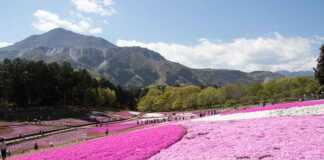If you’re planning a trip to Japan to see the snow monkeys, you’re probably picturing them in winter. Seeing those blessed little Japanese snow monkeys sitting in hot springs keeping their nether regions warm with ice and snow around them is very cute. But what you may not realise is you can also see these same creatures (or at least their more sensible relatives) in the luxury of warmer climes at Arashiyama Monkey Park near Kyoto.
We visited as part of our 10 days in Japan but if you’re following an Osaka itinerary, this is one of the places you could visit also.
In May, the monkeys are more relaxed as they don’t have to fight for the hottest tub (the losers get left out to shiver in the cold).
When the weather is warmer, these monkeys are free-roaming and enjoy a mountain park with a view.
Contents
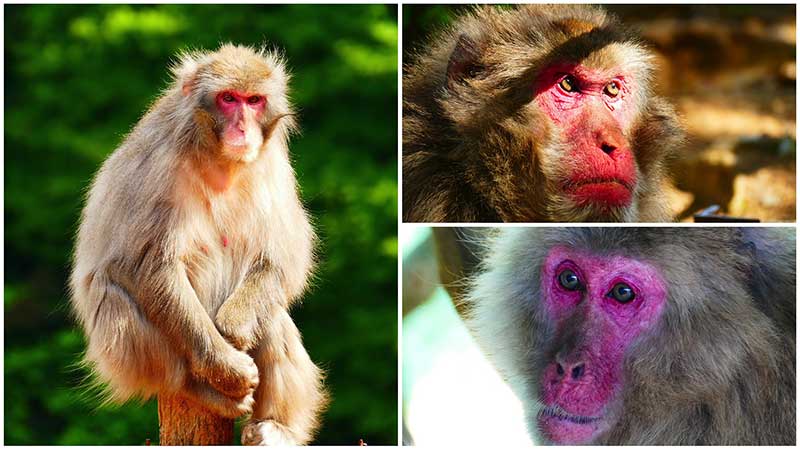
For more about Japan, read:
- 20 Incredible Landmarks in Japan
- 20 Best Beaches In Japan
- 25 Things To Do In Tokyo At Night
- 25 Landmarks In Tokyo
- A Guide To Winter In Japan
- 50 Things To Do In Japan
- Japan Itinerary (10 days)
- Where To Stay In Tokyo
- Osaka Itinerary
- Nagoya Itinerary
- Where To Stay In Nagoya
- 12 Things To Do in Takayama
- How To Use The Toilets In Japan
- Osaka Itinerary
- 20 Things To Do In Osaka At Night
- Where To Stay In Osaka
- 20 Things To Do In Hiroshima
- Where To Stay In Hiroshima
- 20 Things To Do In Yokohama
- 15 Things Japan Is Famous For
- 20 Things To Do In Kamakura
- 20 Things To Do In Nagano
- 20 Day Trips From Tokyo
- 3 Day Trips From Osaka
- The Most Beautiful Japan Tourist Spots
- Hakuba Hotels
- Hakuba Ski Resort
- Japanese Onsen Tips
- Where To Stay In Kyoto Like A Local
- Arashiyama Monkey Park
- Eating and Drinking Matcha
- Amanemu Review
- 20 Japanese Drinks
- 20 Things To Do In Kyoto At Night
- 20 Japanese Cities
- 20 Things To Do In Fukuoka
- Where To Stay In Fukuoka
- 20 Things To Do In Nara
- 20 Things To Do In Hakone
- 20 Things To Do In Sapporo
- Where To Stay In Sapporo
- 20 Things To Do In Kanazawa
- 20 Things To Do In Okinawa
- 20 Things To Do In Sendai
- 20 Things To Do In Saitama
ARASHIYAMA MONKEY PARK
Arashiyama is the second most popular tourist destination in Kyoto.
Located in western Kyoto, it’s a small town at the base of the Arashiyama Mountains. Arashiyama is about 30 minutes from central Kyoto.
Arashiyama has many attractions, including famous temples and shrines.
One of the highlights is the well-known Bamboo Grove Walk.
There’s also a lovely boat ride along the Hozu-Gawa River but if you love seeing wildlife, Monkey Park is the place to go.
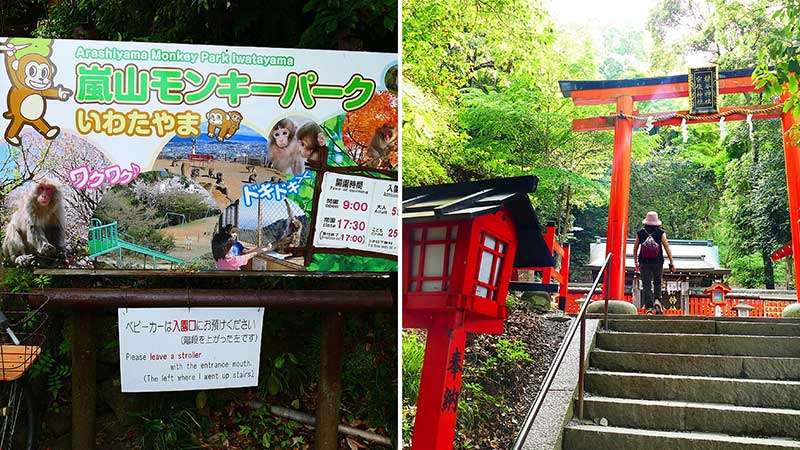
The entrance to Arashiyama Monkey Park is near the left bank of the Oi River, next to the Togetsu-kyo Bridge. It’s located across from the town’s bustling main street.
It’s at the base of beautiful Mt. Arashiyama, where for a modest fee (less than AU$10 per adult) you can enter the environs of the macaques of Mt. Arashiyama.
The ticket office (and Western toilet) is located next to a small shrine at the foot of the hill. You can also receive a blessing before hiking to the top of the hill.
MONKEY PARK WORK OUT
Be warned, the climb is a little steep and certainly gets the heart rate going but if you take your time, it takes a leisurely 25 to 30 minutes.
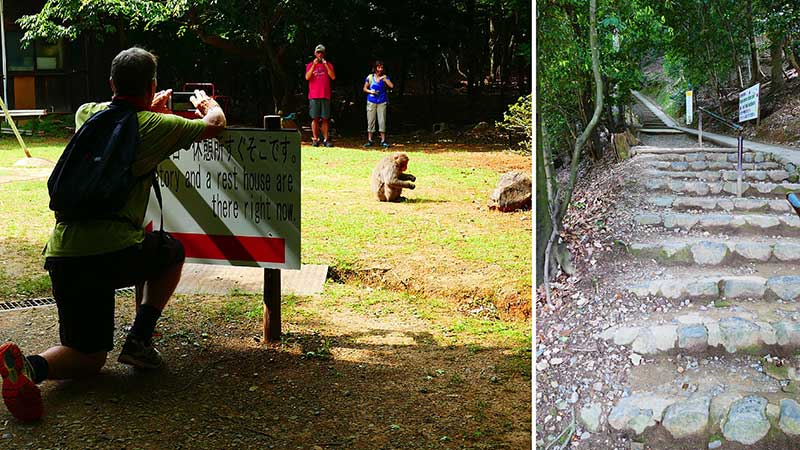
Going slow also allows you time to read and absorb the information on the signs on the hike up.
How you conduct yourself whilst in the presence of such magnificent creatures is very important for your safety and for their protection.
Don’t be fooled when you reach the ‘rest station’ or playground.
We were so excited by seeing three monkeys running around we took about 100 photos, not realising we weren’t quite at the top yet!
The rest stop has a small hut, Japanese toilets and a little park with slides and swings for you (and the monkeys!) to use.
This is just the teaser – if you keep going another five minutes further, you abruptly reach the top of the mountain and suddenly the viewing platform is upon you.
Not only is there an amazing vista of Kyoto but there are monkeys EVERYWHERE!
MONKEY BUSINESS
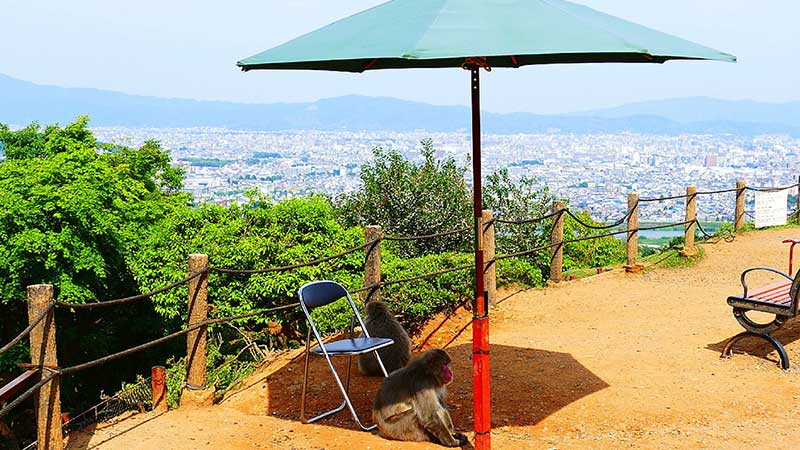
I went crazy at seeing a group of macaques sitting under a sun umbrella and chair, shooting off photos with gay abandon.
Then as my focus slowly shifted away I suddenly saw another hundred or more, just sitting, grooming or slowly wandering around.
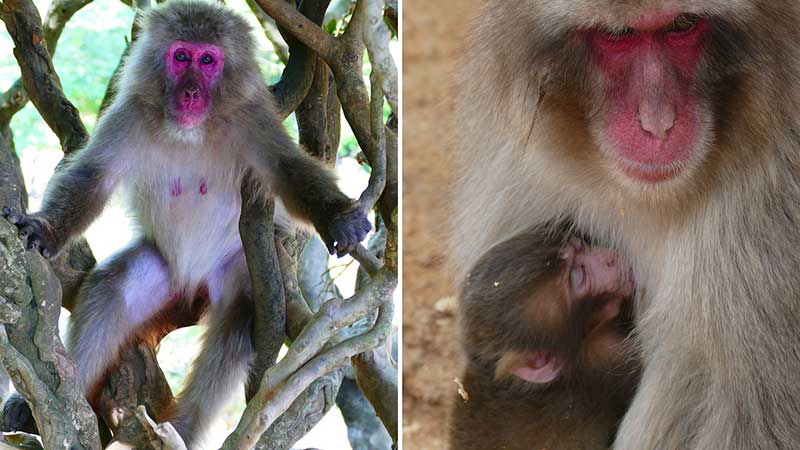
We were at Arashiyama Monkey Park in May, early spring. Since there had been much earlier popular ‘activity’ amongst the males and females in the troops, many babies were also to be seen, some happily wandering and playing, others still too small, clinging to their mums.
They all seemed highly accustomed to visitors and were quite nonchalant about our presence. They carried about their business like we weren’t there.
There was no ‘cheeky’ macaque behaviour that some tourist attractions warn you about, such as stealing things from your pockets or bags.
These extended families were very chilled and well behaved.
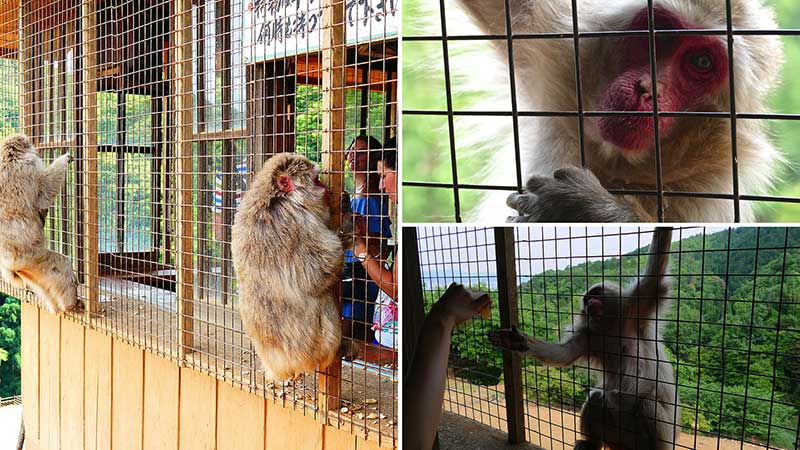
FEEDING THE MONKEYS at Arashiyama Monkey Park
As for feeding the monkeys, the Monkey Park has an unusual arrangement. An old slightly run-down house or visitor’s lodge overlooks the magnificent view from the viewing platform.
Inside there are keepers and a small shop to purchase food for the monkeys, as well as drinks and snacks for your human troop.
The idea is to feed the Japanese macaques from inside the barred windows of the house whilst they come to the windows on the outside.
It’s bizarre seeing monkeys with begging hands through windows whilst the humans are on the inside.
I could have spent all day there just observing these macaques go about their daily business.
What an experience and a photographer’s dream, as you can see, and well worth the hike!
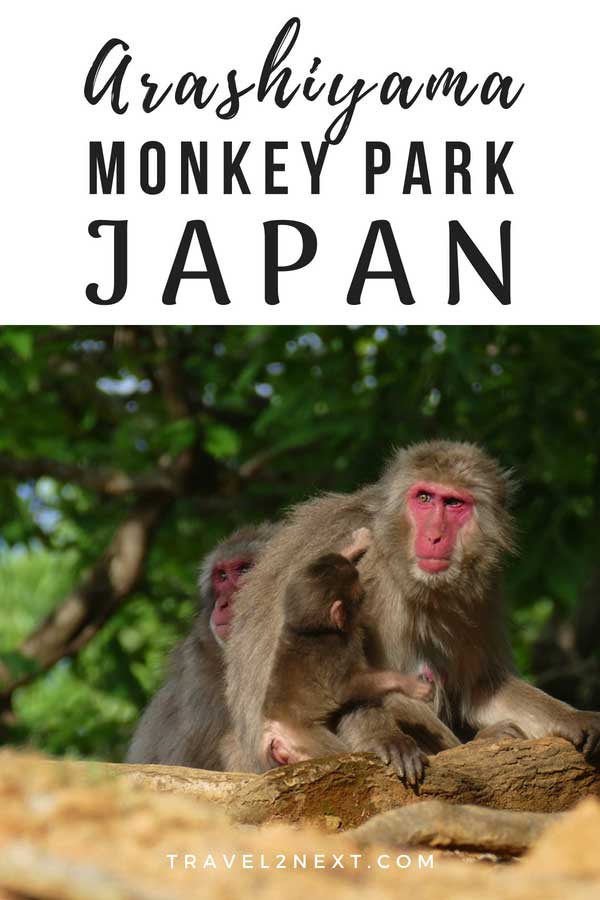

Plan Your Trip

Rent A Car – Find the best car rental rates at Discover Cars. They compare car hire companies to provide you with the best deal right now.

Find A Hotel – If you’re curious about this article and are looking for somewhere to stay, take a look at these amazing hotels.
